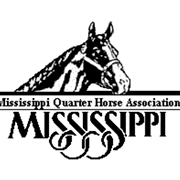In today’s trail world, the name of the game is pole work. We see elevated poles, pinwheels, complicated serpentine trot overs, and many other combinations. For many exhibitors, this becomes the focus of their practice.
However, there are also a number of slow maneuvers like the gate, walk overs, bridge, back thru, side pass and box, that somehow get shoved to the side while trying to make sure your horse never ticks a pole.
GoHorseShow sat down with AQHA World Champion trainer, Ryan Cottingim to discuss these slow maneuvers, how to avoid penalties and how to improve your score.
Why Slow Maneuvers Matter
Most will agree that horses become the most anxious on the slow maneuvers and we’ve all had the horse (or horses) who like to “help” us by going on autopilot and complete the maneuver without us doing a thing.
We also know this is not good because it increases the chance of a penalty.
“Statistically speaking, slow maneuvers have a higher chance of incurring penalties over pole work,” Cottingim said.
Which means (statistically speaking) you should be spending a lot more time than you probably do improving the fundamentals and mechanics of your slow maneuvers.
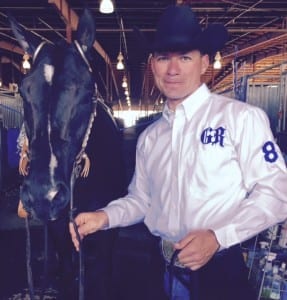 Cottingim said, “I’m very numbers oriented. And I like to consider myself a student of the game. Which means, I concentrate on what I can improve. Generally, this means improving my slow maneuvers.”
Cottingim said, “I’m very numbers oriented. And I like to consider myself a student of the game. Which means, I concentrate on what I can improve. Generally, this means improving my slow maneuvers.”
Therefore, the cornerstone of Cottingim’s training program is for the horse to recognize the slow maneuvers as a place of “quiet time.”
“When I have horses get anxious (at a slow maneuver), I like to take them someplace else, for example, over some poles,” he said, “this gets their adrenaline going so when I come back to the maneuver they see it more as a place to relax.”
Cottingim explained that his ultimate goal is to get a horse used to releasing their air when he stops before entering a slow maneuver.
“If you let a horse rest after working for about 20 seconds, they will usually let out that large breath of air” he said, “I aim for that when I school my trail horses. I take them over some poles and then bring them back to the maneuver and let them rest til they release that air. Eventually, they just start doing it and they will even do it in the show pen with a much shorter rest, let’s say two seconds.”
This sign from your horse lets you know they are relaxed and listening for your next command.
The Bridge
While many see the bridge as a “gimme” maneuver (and it certainly can be), Cottingim had some very valuable advice when it comes to perfecting the bridge.
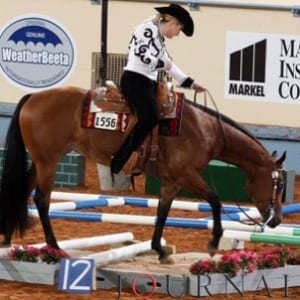 “I see a lot of people who rush through the bridge,” he said, “this ends up with the horse getting ahead of the rider and then the next maneuver becomes more difficult because the rider has lost collection and control of the horse.”
“I see a lot of people who rush through the bridge,” he said, “this ends up with the horse getting ahead of the rider and then the next maneuver becomes more difficult because the rider has lost collection and control of the horse.”
Cottingim likes his horses to move with slow consistent strides over the bridge with the rider controlling each and every step.
“We school our riders to approach a bridge like a walk over,” he said, “As you approach the bridge you should be concentrating on controlling the placement of the front legs and on having soft, slow steps.”
“I don’t like to encourage too much momentum over the bridge either,” he continued, “Riders should be slightly forward as they are coming on the bridge and start leaning back as you come off to continue with the soft, slow steps.”
At home, Cottingim practices with having the horse put their two front feet on the bridge then stopping. He then asks the horse to go forward so all four legs are on the bridge and stops. Finally, he asks them to place their two front feet on the ground, leaving the hind feet on the bridge and stopping again.
Practicing the bridge in this way will help you achieve those soft, slow strides as you walk over the bridge (without stopping) in the show pen.
The Gate
 We’ve all seen (or experienced) the dreaded “rope reach” at some point in the show pen.
We’ve all seen (or experienced) the dreaded “rope reach” at some point in the show pen.
For Cottingim, this is the biggest mistake he sees on the gate, so he likes to break it into four sections when practicing at home.
“Basically, I want to say whoa four times while putting the entire maneuver together,” he said.
“I like to stop with my shoulder at the far jump standard where you will grab your rope. This is the first time I say whoa and let my horse rest. If you stop with the horse’s shoulder to the standard, chances are if he backs up half a step, you’re now in a bad spot and will have to reach, so make sure you ride defensively and stop with your shoulder at the standard.”
Cottingim then asks his horse to back with soft, slow steps to the other jump standard until your shoulder is even with it.
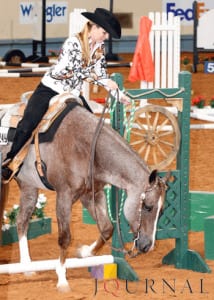 “Most trail patterns have a gate pole nowadays,” he said, “and I like my horses to step over the pole with their front lead foot first [depending on direction of travel]. I also teach riders that they need to give the horse’s front feet a place to go where the hind feet will follow. So I have them count three steps to make sure they have cleared that gate pole before turning to close the gate.”
“Most trail patterns have a gate pole nowadays,” he said, “and I like my horses to step over the pole with their front lead foot first [depending on direction of travel]. I also teach riders that they need to give the horse’s front feet a place to go where the hind feet will follow. So I have them count three steps to make sure they have cleared that gate pole before turning to close the gate.”
Once the gate pole is cleared and your horse is back parallel with the gate at the jump standard, Cottingim says whoa for the third time.
Lastly, Cottingim backs up, closes the gate, and says whoa for the fourth and final time.
This method of practicing the gate helps to keep a horse focused and less anxious so your gate flows smoothly in the show pen.
Walk Overs
 Walk overs can appear in many different places in a trail pattern, but no matter where they appear, Cottingim says your approach to the first pole is always the most important.
Walk overs can appear in many different places in a trail pattern, but no matter where they appear, Cottingim says your approach to the first pole is always the most important.
“I like for my horses to take off about 6-8 inches in front of the first pole,” he said, “So that’s where I look because your eyes are going to guide your horse through the walk overs.”
Once your horse’s first front leg takes off, your eyes should shift to the center of the gap between the poles.
“Walk overs generally have a two or four foot gap between them and your eyes should move from gap to gap as your horse is going over the poles,” Cottingim said, “You also can’t quit riding once you get to the last pole. I see this a lot, where the rider relaxes too much and the horse inevitably ticks that last pole.”
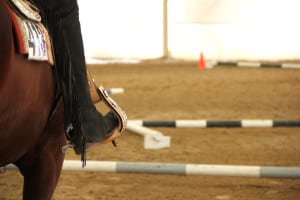 Cottingim teaches his riders to count four beats after the last pole to make sure they have cleared it before relaxing.
Cottingim teaches his riders to count four beats after the last pole to make sure they have cleared it before relaxing.
“I also teach them not to look out and above the walk overs,” he said, “this opens up a horse’s stride and the risk of penalty increases.”
In addition, Cottingim said one of the most important things for a rider to know is their horse’s energy and to adjust how they execute the walk overs accordingly.
“Of course it is a great ‘style’ [for the rider] to have their body up and slightly forward while going over walk overs but if your horse is a big strided horse, or has gotten ahead of you throughout the pattern, or just isn’t having a great day, it is unwise to risk a penalty for style. You have to evaluate your situation and adjust accordingly.”
Speaking of Style…
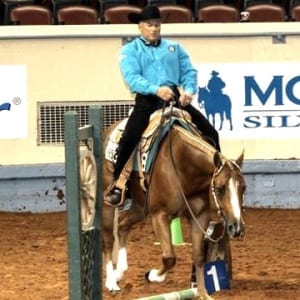 There was one mantra or thesis that seemed to permeate all of Cottingim’s advice, he said: “show what your horse can do, not what it can’t do.”
There was one mantra or thesis that seemed to permeate all of Cottingim’s advice, he said: “show what your horse can do, not what it can’t do.”
“For example, if I’m showing a 16.3hh horse that weighs 1250 lbs. and doesn’t move like a 15hh Cadillac, I am not going to increase speed in the box and risk a penalty over it. The fundamentals and mechanics of each obstacle come first.”
This idea of showing what your horse can do, and not what it can’t do applies to all maneuvers and Cottingim recommends waiting for the high level shows like the Congress and World to really let it fly.
“Of course it is more appealing to the eye when a horse has a nice consistent pace throughout the whole pattern, and you see this at the big shows,” he said, “but let me tell you, you can’t keep that pace all year long, you’ll use up your horse and then you have to spend a lot of time repairing the damage.”
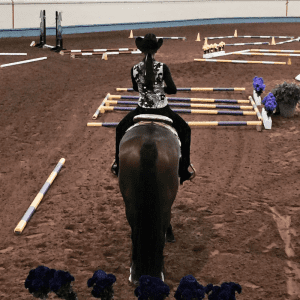 This means at your weekend shows, slow it down, make sure your maneuvers are correct, and above all make sure you do your homework at well, home.
This means at your weekend shows, slow it down, make sure your maneuvers are correct, and above all make sure you do your homework at well, home.
“Practice doesn’t make perfect, practice makes permanent,” Cottingim said, “how you’re practicing at home is what your horse is going to carry into the show pen. I like to practice consistently so the horse has some muscle memory and consistency when we go to show.”
Perfecting slow maneuvers takes a lot of time, patience, and consistency and if you do that at home, at the show you will really be able to show what your horse can do.




